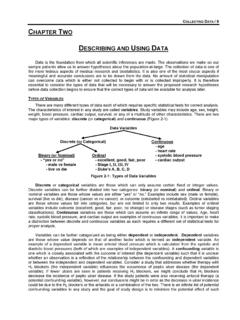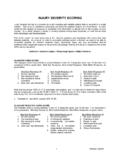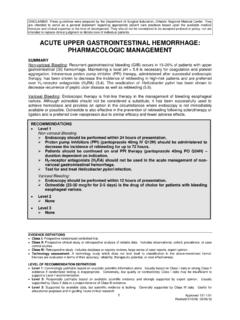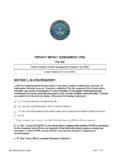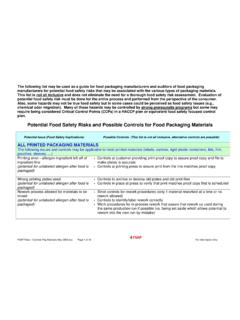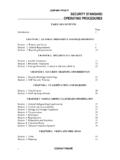Transcription of RHABDOMYOLYSIS: PREVENTION AND TREATMENT
1 DISCLAIMER: These guidelines were prepared jointly by the Surgical Critical Care and Medical Critical Care Services at Orlando Regional Medical Center. They are intended to serve as a general statement regarding appropriate patient care practices based upon the available medical literature and clinical expertise at the time of development. They should not be considered to be accepted protocol or policy, nor are intended to replace clinical judgment or dictate care of individual patients. EVIDENCE DEFINITIONS Class I: Prospective randomized controlled trial. Class II: Prospective clinical study or retrospective analysis of reliable data. Includes observational, cohort, prevalence, or case control studies. Class III: Retrospective study. Includes database or registry reviews, large series of case reports, expert opinion. Technology assessment: A technology study which does not lend itself to classification in the above-mentioned format.
2 Devices are evaluated in terms of their accuracy, reliability, therapeutic potential, or cost effectiveness. LEVEL OF RECOMMENDATION DEFINITIONS Level 1: Convincingly justifiable based on available scientific information alone. Usually based on Class I data or strong Class II evidence if randomized testing is inappropriate. Conversely, low quality or contradictory Class I data may be insufficient to support a Level I recommendation. Level 2: Reasonably justifiable based on available scientific evidence and strongly supported by expert opinion. Usually supported by Class II data or a preponderance of Class III evidence. Level 3: Supported by available data, but scientific evidence is lacking. Generally supported by Class III data. Useful for educational purposes and in guiding future clinical research. 1 Approved 02/01/2005 Revised 10/07/2009, 07/27/2015 rhabdomyolysis : PREVENTION AND TREATMENT SUMMARY With an increasing knowledge and understanding of the disease, rhabdomyolysis (RM) is being seen with increasing frequency.
3 A disease originally described in patients with crush injury, more and more non- traumatic causes are being elucidated. A high index of suspicion is necessary to allow prompt recognition and TREATMENT to avoid the development of acute renal failure (ARF) and need for hemodialysis. Classically, the process was treated with fluid administration and various diuretics as well as bicarbonate therapy in an attempt to alkalinize the urine. Most recently these adjuncts have come into question, and it appears that prompt recognition and aggressive volume replacement is all that is needed to avoid renal deterioration. INTRODUCTION RM has been described as the dissolution of sarcolemma of muscle and the release of potentially toxic intracellular components into the systemic circulation and the attendant consequences (1). RM has the potential to cause myoglobinuric ARF. The incidence of ARF in RM is 10-30% and 10-15% of ARF in the United States is from RM.
4 RECOMMENDATIONS Level 1 None Level 2 Lactated Ringers solution is the fluid of choice when attempting to maintain adequate urinary flow in patients with rhabdomyolysis . Level 3 In patients with RM and a good urinary response to fluid administration, alkalinization of the urine with bicarbonate and the addition of mannitol are unnecessary. In patients with RM unresponsive to fluid administration alone, alkalinization of the urine and addition of mannitol is warranted. Unless there is a danger of hyperkalemic arrhythmia, the infusion of calcium is not indicated. In patients with RM, it is important to minimize other potential renal insults (such as nephrotoxic antibiotics, intravenous contrast media, ACE inhibitors, NSAIDS, ). Serial CK measurements to monitor the resolution of RM are not warranted Male patients, patients with a high BMI above 55 or those undergoing an operation longer than 4 hours are at a high risk for RM and possible gluteal compartment syndrome 2 Approved 02/01/2005 Revised 10/07/2009, 07/27/2015 Creatine phosphate (CP) is found in striated muscle and is a reservoir of high energy phosphate bonds.
5 CPK catalyzes the regeneration of ATP from the combination of CP with ADP. In RM, muscle cells die and release this enzyme into the bloodstream. Myoglobin (MG) is an oxygen binding protein that composes 1-3% of the dry weight of skeletal muscle. It has a high affinity for oxygen and accepts oxygen molecules from hemoglobin in the bloodstream. With muscle damage, free MG in the blood leads to myoglobinemia. Normally, low levels are well tolerated and are cleared by the reticuloendothelial system, but at high levels binding and normal clearing mechanisms become saturated, eventually leading to myoglobinuria and the potential for renal injury and ARF. Myoglobinuria is the presence of MG in the urine. The urine is found to be dipstick positive for blood despite the absence of erythrocytes on microscopic examination. MG contains iron, the toxic effects of which are described below.
6 MG also has the potential to release vasoactive agents such as platelet activating factor and endothelins that may lead to renal arteriolar vasoconstriction, thus worsening renal function. Myoglobin is the first enzyme that increases, but, due to its rapid clearance from the plasma, it returns to normal levels within the first 24 hours after the onset of symptoms. CK increases a few hours later than myoglobin, reaches its peak value within the first 24 hours, and remains at these levels for 3 days. CK is considered to be a more useful marker for the diagnosis and assessment of the severity of muscular injury due to its delayed clearance from the plasma A prerequisite for the development of this disease process is muscle injury, the causes of which are numerous and outlined below. While low levels of ischemia (< hours) are typically well tolerated, as the ischemic time lengthens irreversible muscle damage occurs allowing the release of toxic metabolic byproducts.
7 Reperfusion after a period of ischemia contributes to localized tissue edema mediated by leukocytes, leukotrienes and inflammatory mediators. Cell membranes are damaged, cellular contents leak, and intracellular ATP, the main fuel for cellular membrane pumps, is depleted worsening cellular homeostasis. Another problem is the development of intracellular hypercalcemia leading to the activation of intracellular autolytic enzymes that damage cell membranes leading to the cells vulnerability to oxygen free radicles with reperfusion. There are various causes of RM: vascular interruption, ischemia-reperfusion, crush injury, improper patient positioning, alcohol ingestion, seizures, extreme exercise, electrical injury, infection, hyperthermia, and steroids and neuromuscular blockade (especially in combination). With heightened suspicion for this disorder, non-traumatic causes are being seen with increasing frequency.
8 A special group that has recently been seen to be at risk is bariatric surgery patients. RM is a recently recognized complication of bariatric surgery that may be increasingly seen in clinical practice as the popularity of bariatric surgery is gaining momentum. Several longitudinal studies have found rates of RM after bariatric surgery ranging from 7-77%. A rare syndrome leading to RM specifically related to these patients is known as gluteal compartment syndrome. PHYSIOLOGICAL BASIS OF TREATMENT MODALITIES The most important component with regard to the TREATMENT of patients with RM is the ability to recognize the disease process in a timely fashion to prevent the consequences of myoglobinuria. Worsening renal function as evidenced by increasing blood urea nitrogen (BUN) and creatinine, oliguria, classic tea colored urine , and an elevated serum CPK level all but make the diagnosis.
9 Other findings include hypocalcemia, hyperkalemia and the potential for cardiac toxicity, hyperuricemia, hyperphosphatemia, lactic acidosis, and disseminated intravascular coagulation (DIC) from thromboplastin release. The cornerstone of TREATMENT is aggressive volume resuscitation and expansion of the extracellular fluid compartment. Other modalities described include the use of bicarbonate in an attempt to alkalinize the urine, mannitol, and iron chelators (deferoxamine). Prompt and aggressive restoration of volume is essential and critical to prevent progression to ARF and the need for renal replacement therapy and its inherent cost, morbidity, and mortality. Volume depletion, hypotension and shock combined with afferent arteriolar vasoconstriction due to circulating catecholamines, vasopressin and thromboxane leads to 3 Approved 02/01/2005 Revised 10/07/2009, 07/27/2015 decreased GFR and deficient oxygen delivery to the renal parenchyma.
10 Volume administration can combat some of these disturbances and also dilutes the MG load and reduces cast formation. High concentrations of MG in the renal tubules cause precipitation with secretory proteins from the tubule cells (Tamm-Horsfell protein) leading to the formation of tubular casts and resultant tubular obstruction to urinary flow. Acidic urine favors this process hence the theoretic benefit of bicarbonate use. These patients are typically already acidotic and have acidic urine. Bicarbonate use increases MG solubility, induces a solute diuresis and can potentially reduce the amount of trapped MG. Complications of overzealous bicarbonate administration, however, include hyperosmolar states, overshoot alkalosis and hypernatremia. The use of Diamox has been used for the development of iatrogenic alkalosis. MG itself has a direct toxic effect as well. MG contains iron, and this moiety is released when metabolized in the tubule cell.


